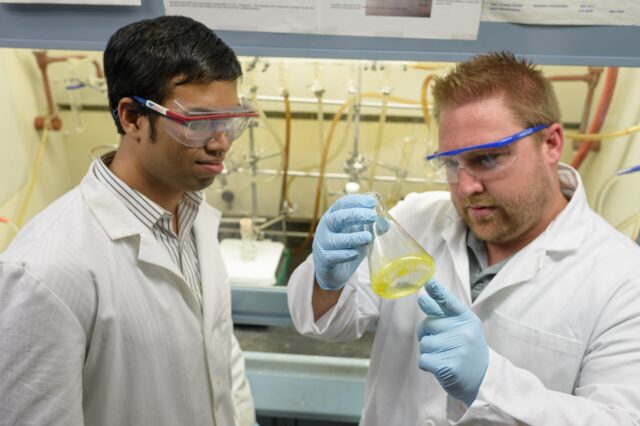Fine-tuning chemistry to destroy bacterial biofilms

Just as a piano tuner adjusts the tension of the strings for optimal sound, medicinal chemists at the University of Florida College of Pharmacy are fine-tuning the structural positions of chemical compounds to find the most promising drug options for killing dangerous bacterial biofilms.
An estimated 17 million Americans are affected by biofilm-associated bacterial infections annually. The biofilm-growing cells are largely resistant to conventional antibiotic treatments and can linger for months or even years.
UF scientists recently discovered that a series of organic compounds called halogenated quinolines, or HQs, can kill dangerous bacterial biofilms present in recurring and chronic bacterial infections such as methicillin-resistant Staphylococcus aureus, or MRSA. In addition, researchers identified a way for chemists to better control the structural elements of HQ compounds which improves the likelihood of developing them into biofilm-attacking drug molecules.
“When you can control the biological activity and properties of a molecule, you have greater potential of developing a drug,” said Rob Huigens, Ph.D., an assistant professor of medicinal chemistry and lead investigator of a study about HQ compounds published in Chemistry – A European Journal. “Our goal is to develop HQ small molecules, so that they can help patients affected by biofilm-associated bacterial infections.”
Chemists synthesize structural representations of molecular frameworks as models to study different chemical groups at different positions in a compound. The representations include a core group of atoms and numbered positions that can be manipulated to develop and test new compounds. Huigens’ team discovered that small changes at a location called the 2-position on the quinoline structure can dramatically impact the potency and ability of HQ compounds to destroy bacterial biofilms.
“We do not yet know why the 2-position of the HQ scaffold is so important, but it is clear that it dramatically influences antibacterial activities,” Huigens said. “In this study, we wanted to develop compounds that have a high degree of structural diversity at the 2-position and evaluate their biofilm-eradication activities.”
UF researchers chemically synthesized 39 HQ compounds with different chemical groups and properties at the 2-position. The compounds were tested in multiple rounds of synthesis and biologically evaluated to determine and better develop their biofilm-eradication potential. The results yielded at least two molecules that were highly potent and warrant more testing.
Equally as important as the discovery of new potent compounds is the newfound control that chemists now have in manipulating future HQ development.
“The advance here is that we can do more in terms of developing HQ compounds through the tweaking of the 2-position,” Huigens said. “This study gives us more information concerning HQs and gives us greater flexibility for future developments.”
Now that researchers know how to structurally position atoms to develop highly potent HQ compounds, the next step is to use the information and incorporate critical aspects for drug properties, such as water solubility. Many organic chemicals are not highly water-soluble, so chemists must walk a fine line in improving water solubility while maintaining drug activity. An effective drug molecule will circulate in the body and distribute everywhere bacterial infections are located, a property that will be examined in a future study of these HQ compounds.
As researchers continue to fine-tune the chemistry involved in developing biofilm-eradicating drugs, each new discovery becomes the starting point for testing more advanced compounds, with the goal of one day eliminating biofilm-associated infections.
About the author
